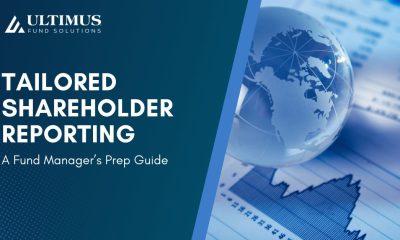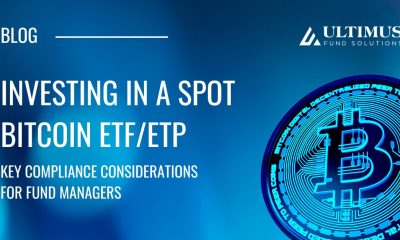Even though the terminology ‘impact investing’ is relatively new in the last 10 years, the concept is not. There are many in the investment arena who are not familiar with details of what impact investing means or what it entails.
With the objective to gain a better understanding of impact investing, using terms such as ESG and SRI, and the influence it is having in the asset management industry among advisers, Ultimus’ Business Development Director, Mick Grunewald, recently spoke with First Affirmative Financial Network’s CEO, George R. Gay. In addition to his role as CEO of First Affirmative, George served on the US SIF (a nonprofit trade association for the SRI industry) Board of Directors from 1994 to 2008, has produced and hosted The SRI Conference since 1990, and received the industry’s 1997 SRI Service Award.
Mick: First off, what does ESG and SRI stand for and what is the difference between the two?
George: ESG stands for environmental, social and governance, while SRI stands for sustainable, responsible impact investing. The ESG factor analysis is a due-diligence process to evaluate corporate behavior; it’s a way to understand what you are investing in or the behavior of the companies you are investing in. SRI, on the other hand, raises the question of why you are or are not investing in certain companies. ESG analysis provides you with the details and the SRI is the value that guides your choice as to whether you will include these securities or not.
Mick: Why should investment advisers be concerned with ESG/SRI principles?
George: I recently read an Investment News article that specifically addressed this subject. It is referred to as the “ESG paradox.” The piece articulated the gap between clients, or potential clients, asking about this subject versus the number of advisers comfortable giving advice about it. A lot of clients are continuing to ask for information about ESG and SRI, so it is extremely important that advisers are knowledgeable on the topic.
Secondly, increasingly, ESG scores tend to identify companies that are well run. And, in general, it is intuitive to believe well-run companies tend to perform better in the marketplace. Increasingly, more and more studies are supporting this conclusion too. Good quality ESG scores tend to result in either slightly better performance, slightly lower risk, or both.
Probably the best compendium of information about research in this area is assembled by the sponsors of the Moskowitz Prize, which is presented each year at the annual SRI Conference, and is administered by UC Berkeley Haas School of Business. The award recognizes outstanding research in sustainable and responsible investing. These groups and others explore shareholder activism, socially responsible mutual funds, and social responsible investing as contributing factors to financial performance.
Mick: How do these two strategies affect the future of investing?
George: Both ESG and SRI strategies are presenting more data in the marketplace. As more data becomes available, understanding how that data is aggregated, pulled together, examined and analyzed is the challenge for the future. There are more sources for data and more data companies (Sustainalytics, MSCI, Bloomberg, etc.) working with data to come up with output. However, the increase in data does not necessarily mean an increase in knowledge. The increased presence of artificial intelligence, which thrives on data, is helpful in assessing this information, but humans are still needed to help make the data meaningful. In the investment community data is used to make investment decisions. But, who is doing it? And how is someone using it? In an algorithm? What are they trying to do with it? That is hard to determine right now – the ways in which all the information is being used and manipulated.
Mick: What is the trend with millennials investing in these strategies?
George: Every survey that I have seen on this topic says that millennials are concerned with impact and sustainability. The market exists in such a way that the products out there can confuse the issue for investors concerned with impact investing. Two of the biggest issues of the future are measuring impact and displaying it in a way that people can make an informed decision. I think millennial investors want better information. However, I don’t think we know how to be successful in giving them that yet.
Mick: How does ESG/SRI fund performance compare to non-ESG/SRI funds?
George: The best way to answer this question is to look at the MSCI KLD 400 Social Index, previously known as the Domini Social Index (created in April 1990). This index was designed to compare the performance of a screened universe of securities with that of the S&P 500. For 28 years the socially screened index has outperformed the S&P 500 by between 0.4 – 0.6%. And generally, the screened securities perform better in the growth stages, while the S&P 500 has performed better in value style market. Broadly speaking, growth phases tend to last longer than value phases. Large Cap U.S. investments, screened for the common social screen, have historically performed a little bit better than S&P 500 with very small additional risk (1.02 vs 1.0).
More importantly, when comparing SRI packaged products in mutual funds to other mutual funds, the differentiating factor tends to be cost. Performance of the SRI investment portfolios are competitive almost all of the time. SRI funds historically have been more expensive because they are smaller, lacking economies of scale that bigger, conventional funds have. SRI funds do extra work – ie, screening, shareholder advocacy, etc. This causes SRI products to be more expensive. So, net of expenses, performance relative to the big conventional funds has had a slight drag.
SRI expenses across the board have been declining. Acquisitions and consolidations like Eaton Vance and Calvert and PAX and Impax have also helped increase average fund sizes and reduced costs.
Mick: What are the common misconceptions regarding ESG/SRI investing?
George: As just discussed, the expectation of poor performance is by far the biggest misconception with SRI’s and most likely identified within the investment landscape.
The second misconception centers on the screening process and how values are assigned. I am working on a session for our 29th Annual SRI Conference in the fall. The session will cover why all social screens aren’t the same. A lot of people expect them to be and they are not.
The screen questions asked by investors vary. Many investors of faith-based funds approach this from a morally responsible/ faith-based process. There are other people who approach this from a political process. Often in the press there is this very baffled question ‘why aren’t all these screens the same’.
For example, let’s take a gun manufacturer. It’s conceivable that a gun manufacturer could have a good ESG score but an investor might say, “I really don’t care how good their score is, they are still making guns and I would rather not own that.” Another company that has scored well is Monsanto, but a lot of investors still don’t want to own their stock because of some of their business practices.
Types of SRI Screens Used Today by Advisers –
1 – Zero Tolerance: this is a little misrepresentative because it’s nearly impossible to have zero exposure to a product. But take tobacco, there are certain industries, such as this, where the product itself is dangerous. Using tobacco as an example, while it is relatively easy to have no exposure to a cigarette manufacturer, you would need to determine if you wanted to look to see if there are any revenues that come from selling cigarettes. Generally, all SRI funds want zero exposure to tobacco manufacturers. This is also the case with guns.
2 – Best of Class: if we do not want to rule out all cigarette companies, but we don’t want to invest in the worst ones, we can use ESG analysis to figure out the best cigarette company. In another area, such as gold mining, there is a wide range of quality between the best of class and worst. Some investors do not want gold mining at all because of the environmental impact. It is up to the investors to come up with a range of areas upon which they are going to evaluate a company. They will have some industries in which they do not want any exposure, and there will be other industries in which they want to have the best quality companies they can find.
3 – Intentionality: this screen looks at the reasons behind a good environmental impact score – is it a part of a company’s policy, do they have an investment commitment that results in deliberate and measurable consequence (a great environmental score) or is it just because they happen to be in an industry where they do not have that much of an impact on the environment.
Mick: How can investment advisers learn more about these strategies?
George: This is a subject where I do have a bias, and I will start with a couple of things.
USSIF – This is non-profit trade association that represents this portion of the industry. They are headquartered in Washington DC. I spent 12 years on the board of directors and I am very familiar with them. USSIF is a good quality, non-profit trade association and a great resource. They also host a conference in the spring focused on policy and institutional type activities and a lot of key people involved with ESG/SRI investing attend.
College for Financial Planning – just announced this fall they will be offering Professional Designation in the area of ESG/SRI.
SRI Conference – In my opinion, this remains the broadest scope conference of the industry. Over time, there have become more focused events (illiquid impact investments, community development investments, etc). If you want the best view of the entire industry, especially as an adviser, the SRI Conference delivers that. We had just under 800 people at the 2017 conference in San Diego last fall. We hope to substantially increase that number in Colorado Springs in 2018.
First Affirmative – For someone who is seriously interested in SRI, we have an annual subscription package that includes the conference, a corporate social screening tool, information on proxy voting, and other services. We are part of the Folio Financial, Inc. family, which means that we also offer advisers innovative brokerage and custody technology that facilitates SRI investing. For example, we help advisers use fractional share investing technology to give their largest and smallest customers well diversified, SRI focused portfolios.
For blogs, Green America, an advocacy group for sustainability, is a good resource.
Natural Investments, a portfolio management firm, recently published “The Resilient Investor” and there are numerous other good books on the topics of sustainable investing.
Mick: For investment advisers, how can they integrate ESG/SRI into their practice?
George: Advisers who offer SRI investing are the same as other advisers, with one important exception: they have additional knowledge, tools and techniques that can help align customers’ values and their portfolio. Being in SRI does not replace anything in the risk management or financial planning process. Rather, it adds an additional filter or conversation point with the client. That is important to note because a lot of advisers come to First Affirmative because they need to learn more about SRI and the various ways they easily incorporate SRI into their offering. We encourage advisers to think about SRI as something that enhances – not separates – their expertise, value and customer relationships. Advisers can get additional training. The College for Financial Planning will be offering some programming soon. US SIF offers a course 3-4x a year called Fundamentals of Sustainable and Responsible Investment (3-hour course), which is also offered online. And, of course, there is the annual SRI Conference, which will include the US SIF Fundamentals training as a pre-conference event.
Another great source of information is older school fund companies, such as Calvert, Domini, Pax, Praxis, Parnassus. Fund companies that have embraced SRI for a long time, and their websites have a lot of information. US SIF has a lot of good info. All are great sources for additional information.
Mick: Another thing we haven’t discussed is Shareholder Advocacy. Care to weigh in on that?
George: Shareholder advocacy is a very important part of the ESG/SRI process, particularly with proxy voting. Shareholder resolutions and the companies actively involved with advocacy is a major part of the way the investment industry, and specifically shareholders, interact with management at corporations. There were around 400 shareholder resolutions filed last year (clients / investors can file resolutions themselves). The shareholder resolutions typically provide transparency about the corporation and its operations. Resolutions encourage corporate responsibility and discourage practices that are unsustainable, unethical or increase exposure to risk.
This is the least well-known part of our industry but probably the most impactful.
Mick: Any final thoughts you want to share about First Affirmative Financial Network?
George: You can check out our website to learn more about proxy voting guidelines. If you just want to get an idea of the kinds of things that come up for a vote, by looking at our guidelines, you will see our observation on each policy and how we would vote on these things. I truly believe that our firm works for the benefit of retail investors, and our policies are the most comprehensive available.
Conclusion
Mick: Thank you, George, for your time today, and for providing insightful information about this growing segment of the financial community. At Ultimus, we work with several SRI funds and believe this topic is of increasing importance to the industry, and so we appreciate your help to shed light on it. This information will help investment advisers better understand ESG/SRI principles.
To learn more about ESG/SRI investing, please click any of the above hyperlinks.
Mention of specific securities is not an offer to buy or sell that security. For information on the suitability of any security for your portfolio please contact your financial adviser.



